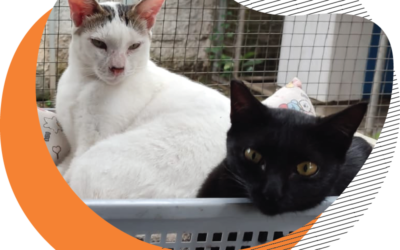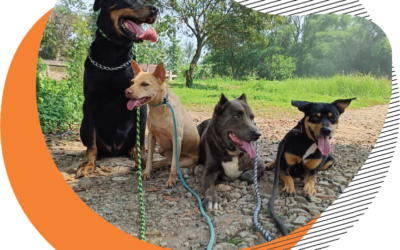
More Than Just War Victims: Those Rarely Spotlighted by the Mass Media
By : Arditya Laksono
Freelance English Tutor
Translator : AWI Team
The sound of bullets whistling and bomb explosions shook the ground. Black smoke and thick dust from buildings destroyed by bombs rose in the sky. Residents and animals in the area were frightened and ran for safe shelter. That’s what the hustle and bustle of war in areas of armed conflict such as Gaza and Ukraine has been like in recent times. So many human victims fell as a result of the war.
However, it is not only humans who are victims of war; animals also feel the same impact. Often, those who cannot speak (animals) are
neglected. Domestic animals, livestock, and wildlife alike are victims of conflict, suffering pain, hunger, and fear.

Read Also : HOW TO IDENTIFY CRUELTY TO ANIMALS
No war has a happy ending; there are always parties who suffer the most from this event, and animals are one of them. The Conflict and Environment Observatory website reveals that animals are the victims who suffer the most when war occurs, and existing international policies do not include adequate support for animal welfare. Therefore, the fate of animals in areas of armed conflict is often neglected.
Those who are voiceless and neglected
The mass media often only reports on the human-victim side of armed conflict. However, humans are not the only ones who are victims. Pets abandoned or separated from their owners roam the streets, looking for food and shelter. Not infrequently, they become victims of stray bullets, bomb explosions, and even being buried in collapsed buildings. Livestock whose owners were forced to leave them stranded on farms until they got sick. Wild animals, both in zoos and in the wild, lose their habitats, are injured by bullets, bombs, and land mines, and can even become prey for opportunists who are taking advantage of the chaotic regional situation.

Light in the dark: Those who fight for animals in war zones
Behind the many news stories and statistics of casualties and material losses due to war that appear in the headlines, there are moving stories about the struggles of individuals and organisations fighting to save these animals. The following are some small examples of stories of the struggle of individual volunteers and organisations to save animals in conflict zones:
1. The story of Maria Vronska from Ukraine, who built a shelter for 700 cats and dogs abandoned in Kyiv due to the Russian-Ukrainian war.
2. The story of Ewa from Poland and Nataliia Popova from Ukraine, who risked their lives to save Ukrainian wildlife from the Russian-Ukrainian war.
3. The story of Saeed All Er from Sulala Animal Rescue, who struggled
with the gripping war in Gaza to save animals such as abandoned
dogs, cats, and donkeys with limited resources.

These stories are a reminder that animals, like humans, are living creatures capable of feeling pain and suffering. They also both have precious lives, and they only have the chance to live once in this world. Animal welfare in conflict zones is not just a matter of compassion but also a matter of public health. Sick and dead
animals have the potential to spread disease to surrounding communities. It’s hard to imagine how difficult the situation would be if this situation were left unchecked. Already sick and injured from the war, citizens had to be bothered by zoonotic diseases caused by sick and dead animals.
Read Also : Stray Animals, Who Are They?
How can we take action?
Protecting animals in zones of armed conflict is a shared responsibility. We can support organisations working in the field by signing up to volunteer or donate to rescue efforts, emergency care, and educational programmes to raise awareness about the issue. The following are some examples of charitable organisations that focus on the safety of animals in war zones:
1. Sulala Animal Rescue
2. International Fund for Animal Welfare (IFAW)
3. Warpaws
4. Fourpaws International
5. World Animal Protection Internationa
Every action, no matter how small, can make a difference in the lives of animals suffering from war. By collaborating, we can help create a safer and more compassionate world for all living things.

Read Also : Animal’s Level and Response to Traumatic Events



Source:
https://ceobs.org/how-animals-are-harmed-by-armed-conflicts-and-military-activities/ https://www.ifaw.org/international/press-releases/animals-people-war-impact-conflict https://www.voanews.com/a/saving-animals-during-war-ukrainians-honored-for-their-work/7567827.html https://abcnews.go.com/International/few-resources-left-gaza-animal-rescuer-sulala/story?id=106974094 https://sulalaanimalrescue.com
Photo source:
https://www.pexels.com/photo/a-cat-walking-in-the-building-ruins-17543795/ https://www.pexels.com/photo/photo-of-a-cat-sleeping-on-gray-concrete-bench-757457/ https://www.pexels.com/photo/brown-tabby-cat-on-brown-and-beige-floral-sofa-chair-10353244/ https://www.pexels.com/photo/animal-skull-on-pebbles-17633642/ https://www.pexels.com/photo/skull-of-buffalo-on-meadow-20349961/ https://www.pexels.com/photo/cute-dog-hiding-inside-a-cage-9862785/ https://www.pexels.com/photo/happy-dog-in-kennel-lined-with-newspapers-16583180/ https://www.pexels.com/photo/a-veterinarian-vaccinating-a-dog-7469213/ https://www.pexels.com/photo/person-putting-bandage-on-the-dog-s-hand-7474853/
Related Post
Things you need to know about your cat’s natural behavior
Things you need to knowabout your cat’s natural behaviorCat’s natural behavior is related to age, personality and past experience. Cats really love to play, both with their humans or toys. Playing and moving around is really important for their physical and mental...
TREATMENT OF PRIMATES FOR COMMERCIAL PURPOSES SEEN FROM ANIMAL WELFARE POINT OF VIEW
TREATMENT OF PRIMATESFOR COMMERCIALPURPOSES SEEN FROMANIMAL WELFAREPOINT OF VIEW By: Atian Muhammad Zaky Fahrian Translator : Ludmila The first thing I’d like to address is that there are many content creators who keep wild animals and show them on their social media...
Pets as property in Animal Welfare
Pets as propertyin Animal WelfareCitayam Fashion Week in Jakarta is now booming and attracts people’s attention, especially those with a passion for the modeling world. This weekly event shows street fashion a la Harajuku in Japan which attracts people both locally...
Feline Behavior Guidelines
FelineBehaviorGuidelines By: Drh.Mikeu Paujiah, Dipl.Montessori The benefits of living with a pet are now well recognized. By preventing and treating behavioral problems, we have the opportunity to protect and strengthen the human-pet-veterinary bond and increase the...
A Few Tips to Minimize The Stress to The Pets During The New Year Eve
A few tips to minimizethe stress to the petsduring the New Year Eve Pets which not familiar with loud sound will have fear then have stress and frustration.Stress will decrease immunity,and if this happens in the long term, eventually will affect pets behavior and...
Tips on How to Create a Happy Shelter for Animals
Tips on How to Createa Happy Shelter forAnimals A shelter is a momentary place for animals. By: Drh.Mikeu Paujiah, Dipl.Montessori Translator : Azzahra Maulidina, BVM A shelter is a momentary place for animals. Animals in a shelter have different types and backgrounds...





